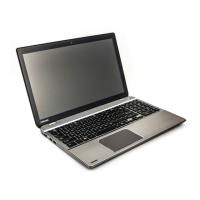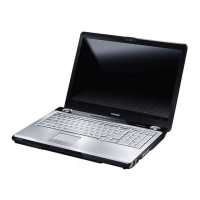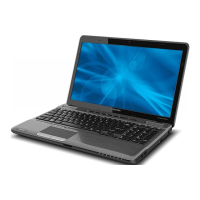
Do you have a question about the Toshiba Satellite P50-A Series and is the answer not in the manual?
| Storage | 1TB HDD |
|---|---|
| Display | 15.6-inch Full HD (1920x1080) |
| Graphics | NVIDIA GeForce GT 740M (2GB DDR3) |
| Operating System | Windows 8.1 |
| Battery | 4-cell Lithium-ion battery |
| Optical Drive | DVD SuperMulti drive |
| Wireless | Wi-Fi 802.11 a/b/g/n |
| Bluetooth | Bluetooth 4.0 |
| Ports | HDMI, Ethernet, Headphone/microphone combo jack, SD card reader |
Details copyright, disclaimer, and trademark information for the manual.
Covers FCC and other regulatory compliance information.
States compliance with European Directives and provides website for Declaration.
General safety precautions for using the computer and AC adapter.
Importance of ventilation to prevent overheating.
Guidance on setting up a proper workspace for the computer.
Lists items included in the computer package for verification.
Explains manual's formatting for terms and procedures.
Provides basic steps to begin using the computer.
Explains different modes for powering down the computer.
Describes the front view of the computer with the display closed.
Details the ports and indicators on the left side of the computer.
Details the ports and indicators on the right side of the computer.
Shows the back of the computer.
Shows the underside of the computer.
Shows the front of the computer with the display open.
Information about the internal battery pack.
Information about the processor type.
Information about storage devices (HDD/SSD).
Information about graphics control and features.
Explains how power conditions affect operating capability and battery status.
Describes the status indicated by the DC IN/Battery indicator.
Describes the status indicated by the Power indicator.
Explains how to use the touch screen features and gestures.
Explains how to use the touch pad and its gestures.
Describes keyboard layout, keys, and indicators.
Describes function keys (F1-F12) and their modes.
Instructions for loading and using optical discs.
Steps to remove a disc from the drive.
Describes types of writable discs (CDs, DVDs, Blu-ray).
Usage notes and limitations for the TOSHIBA VIDEO PLAYER.
How display and audio settings affect video playback.
Procedure to start the TOSHIBA VIDEO PLAYER.
Usage notes and limitations for the Blu-ray Disc Player.
Information on using the TV tuner.
How to connect the coaxial cable for the TV tuner.
Explains different types of batteries used in the computer.
Information about the main battery pack.
Important safety precautions for handling the battery pack.
Procedures and time required for charging the batteries.
Steps to connect a LAN cable to the computer.
Information on different types of LAN cables.
Step-by-step guide to installing additional memory modules.
Step-by-step guide to removing memory modules.
Important considerations for memory media cards.
Precautions for handling memory cards.
Instructions for inserting memory media into the slot.
Instructions for removing memory media from the slot.
How to connect external displays to the computer.
Details about connecting to the external RGB monitor port.
How to connect to the HDMI out port.
Steps to connect a security cable to the computer.
Controls audio volume for devices and applications.
How to adjust microphone recording levels.
How to apply sound effects for speakers.
Premium audio enhancement suite for immersive sound.
Describes pre-installed utilities and how to start them.
Uses acceleration sensor to protect HDD from shocks.
Monitors system functions like power, battery, and cooling.
Automatically turns off the display panel after inactivity.
Automatically turns off the hard disk drive after inactivity.
Automatically shuts down system into Sleep/Hibernation Mode.
Provides two levels of password security for system access.
How to set or reset the user password for power on.
Information about setting and using supervisor passwords.
How to start the computer when a password is registered.
How to start the PC Health Monitor application.
Settings window for TOSHIBA HDD Protection.
Option to enable or disable HDD Protection.
Sets sensitivity levels for detecting vibrations and impacts.
Tools to repair startup, run diagnostics, or restore the system.
Instructions on how to create recovery media.
How to restore the system from created recovery media.
How to restore the system using the recovery partition on the HDD.
Guidelines for resolving problems effectively.
Basic checks to resolve common computer issues.
Questions to help identify the cause of a computer problem.
Common issues and their troubleshooting steps.
Steps to take when the keyboard is unresponsive.
How to close programs that have stopped responding.
Basic checks if the computer fails to start.
Troubleshooting power-related issues.
What to do when the computer shuts down due to overheating.
Troubleshooting issues with the AC adapter.
Troubleshooting battery-related problems.
Troubleshooting garbled display output.
Steps to take if the display shows no image.
Troubleshooting issues with booting from the HDD.
Steps to resolve slow hard disk drive performance.
Steps to resolve issues accessing discs in the drive.
Troubleshooting memory card errors.
Steps if unable to write to a memory card.
Steps if unable to read files from memory card.
Troubleshooting issues with the touch pad.
Troubleshooting unresponsive USB mouse operation.
Troubleshooting issues with USB devices.
Steps to take when there is no sound from the computer.
Troubleshooting feedback or annoying sounds.
Steps if the external monitor does not turn on.
Troubleshooting no display on external monitor.
Troubleshooting LAN access issues.
Troubleshooting Wireless LAN access.
Troubleshooting Bluetooth device access.
Steps to take before contacting TOSHIBA support.
Information on how to contact TOSHIBA technical support.
Summarizes the computer's technical specifications.
Details the physical dimensions of the computer.
Specifies operating and non-operating environmental conditions.
Details power requirements for AC adapter and computer.
Specifications for AC power cords and connectors.
Information on Wireless LAN and Bluetooth interoperability.
Information on health aspects of wireless device usage.
Details about the computer's wireless LAN capabilities.
Regulatory information for Canada.
Regulatory information for the USA.
Regulatory information for Taiwan.
Information on using the equipment in Japan.
Lists countries/regions where the equipment is approved.
Explains that not all icons may apply to the selected model.
Explains factors affecting CPU performance.
Requirements for 64-bit computing.
Explains how main system memory is used.
Factors affecting battery life and recharge time.
Information about LCD screen brightness.
Factors affecting GPU performance.
Factors affecting Wireless LAN speed and range.
How copy protection standards may affect media.
Lists common abbreviations used in the manual.











